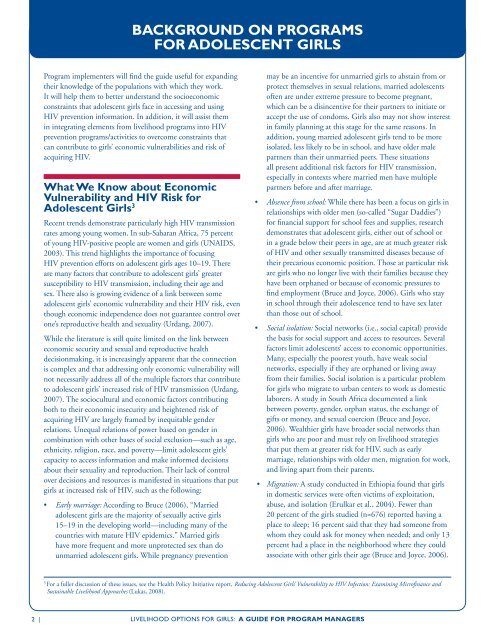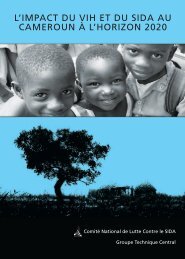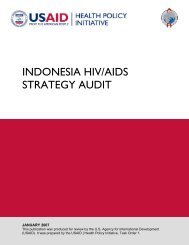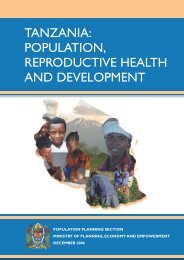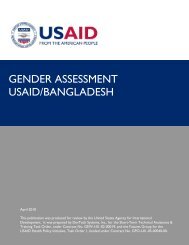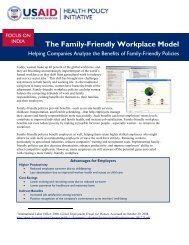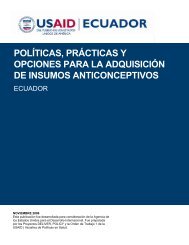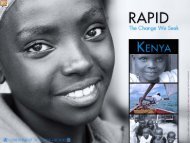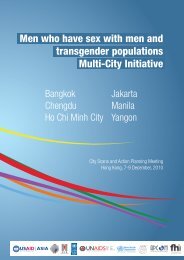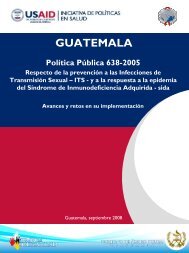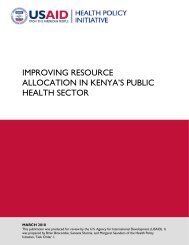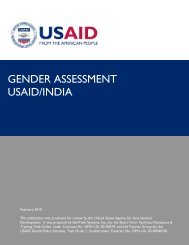LIVELIHOOD OPTIONS FOR GIRLS: - Health Policy Initiative
LIVELIHOOD OPTIONS FOR GIRLS: - Health Policy Initiative
LIVELIHOOD OPTIONS FOR GIRLS: - Health Policy Initiative
- No tags were found...
Create successful ePaper yourself
Turn your PDF publications into a flip-book with our unique Google optimized e-Paper software.
BACKGROUND ON PROGRAMS<strong>FOR</strong> ADOLESCENT <strong>GIRLS</strong>Program implementers will find the guide useful for expandingtheir knowledge of the populations with which they work.It will help them to better understand the socioeconomicconstraints that adolescent girls face in accessing and usingHIV prevention information. In addition, it will assist themin integrating elements from livelihood programs into HIVprevention programs/activities to overcome constraints thatcan contribute to girls’ economic vulnerabilities and risk ofacquiring HIV.may be an incentive for unmarried girls to abstain from orprotect themselves in sexual relations, married adolescentsoften are under extreme pressure to become pregnant,which can be a disincentive for their partners to initiate oraccept the use of condoms. Girls also may not show interestin family planning at this stage for the same reasons. Inaddition, young married adolescent girls tend to be moreisolated, less likely to be in school, and have older malepartners than their unmarried peers. These situationsall present additional risk factors for HIV transmission,especially in contexts where married men have multiplepartners before and after marriage.What We Know about EconomicVulnerability and HIV Risk forAdolescent Girls 3• Absence from school: While there has been a focus on girls inrelationships with older men (so-called “Sugar Daddies”)Recent trends demonstrate particularly high HIV transmission for financial support for school fees and supplies, researchrates among young women. In sub-Saharan Africa, 75 percent demonstrates that adolescent girls, either out of school orof young HIV-positive people are women and girls (UNAIDS, in a grade below their peers in age, are at much greater risk2003). This trend highlights the importance of focusing of HIV and other sexually transmitted diseases because ofHIV prevention efforts on adolescent girls ages 10–19. There their precarious economic position. Those at particular riskare many factors that contribute to adolescent girls’ greaterare girls who no longer live with their families because theysusceptibility to HIV transmission, including their age andhave been orphaned or because of economic pressures tosex. There also is growing evidence of a link between somefind employment (Bruce and Joyce, 2006). Girls who stayadolescent girls’ economic vulnerability and their HIV risk, even in school through their adolescence tend to have sex laterthough economic independence does not guarantee control over than those out of school.one’s reproductive health and sexuality (Urdang, 2007).• Social isolation: Social networks (i.e., social capital) provideWhile the literature is still quite limited on the link between the basis for social support and access to resources. Severaleconomic security and sexual and reproductive healthfactors limit adolescents’ access to economic opportunities.decisionmaking, it is increasingly apparent that the connection Many, especially the poorest youth, have weak socialis complex and that addressing only economic vulnerability will networks, especially if they are orphaned or living awaynot necessarily address all of the multiple factors that contribute from their families. Social isolation is a particular problemto adolescent girls’ increased risk of HIV transmission (Urdang, for girls who migrate to urban centers to work as domestic2007). The sociocultural and economic factors contributing laborers. A study in South Africa documented a linkboth to their economic insecurity and heightened risk ofbetween poverty, gender, orphan status, the exchange ofacquiring HIV are largely framed by inequitable gendergifts or money, and sexual coercion (Bruce and Joyce,relations. Unequal relations of power based on gender in2006). Wealthier girls have broader social networks thancombination with other bases of social exclusion—such as age, girls who are poor and must rely on livelihood strategiesethnicity, religion, race, and poverty—limit adolescent girls’ that put them at greater risk for HIV, such as earlycapacity to access information and make informed decisions marriage, relationships with older men, migration for work,about their sexuality and reproduction. Their lack of control and living apart from their parents.over decisions and resources is manifested in situations that put• Migration: A study conducted in Ethiopia found that girlsgirls at increased risk of HIV, such as the following:in domestic services were often victims of exploitation,• Early marriage: According to Bruce (2006), “Married abuse, and isolation (Erulkar et al., 2004). Fewer thanadolescent girls are the majority of sexually active girls20 percent of the girls studied (n=676) reported having a15–19 in the developing world—including many of the place to sleep; 16 percent said that they had someone fromcountries with mature HIV epidemics.” Married girls whom they could ask for money when needed; and only 13have more frequent and more unprotected sex than dopercent had a place in the neighborhood where they couldunmarried adolescent girls. While pregnancy prevention associate with other girls their age (Bruce and Joyce, 2006).3For a fuller discussion of these issues, see the <strong>Health</strong> <strong>Policy</strong> <strong>Initiative</strong> report, Reducing Adolescent Girls’ Vulnerability to HIV Infection: Examining Microfinance andSustainable Livelihood Approaches (Lukas, 2008).2 | <strong>LIVELIHOOD</strong> <strong>OPTIONS</strong> <strong>FOR</strong> <strong>GIRLS</strong>: A GUIDE <strong>FOR</strong> PROGRAM MANAGERS


